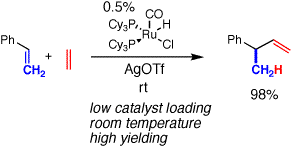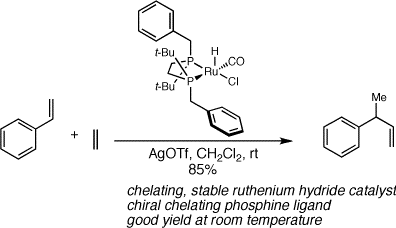Reports: G1
47139-G1 Asymmetric Hydrovinylation and Related Reactions
The goal of this research is to develop stable ruthenium hydride catalysts
that will mediate the enantioselective hydrovinylation.
Initial work was directed toward the development of a catalytic
hydrovinylation reaction based on a stable ruthenium complex. We began
this process by
utilizing a ruthenium hydride complex containing two monodentate
phosphine ligands. This complex is easy to synthesize in one step and
can be made readily on multigram scale. This is key to acceptance as an
important catalyst in the organic community. We have shown that this
catalyst is active at room temperature, and is capable of reacting with
both electron-rich and electron-poor arene substrates.
The stable The key to developing this ruthenium catalyst was treatment of the stable ruthenium hydride precatalyst with silver(I) triflate (AgOTf) to generate a ruthenium triflate in situ. This generated an active catalyst capable of mediating all the desired organic transformations. The catalyst operates very efficiently at room temperature, whereas previous catalysts we investigated required the application of external heat to effect catalyst turnover. The catalyst is mild enough that the product olefins are stable to the reaction conditions and do not polymerize, as is the case with other highly active catalysts.
These catalysts are especially effective at low loadings and low concentrations. By taking advantage of lower catalyst loadings than are normally necessary in transition metal-catalyzed transformations, we can now very effectively produce our desired coupled products with only 0.5 mol% of catalyst. These catalysts undergo bimolecular decomposition under at moderate to high concentrations, but can catalyze the desired transformation at low concentration, so we are not limited by this decomposition pathway under standard reaction conditions. This is a highly desired reactivity profile that we continue to exploit.
The desireable features described above lead us to continue to develop this reaction into an enantioselective version. The next step was to place chelating phosphine ligands on the ruthenium metal center. We synthesized the first pentavalent ruthenium hydride complexes containing chelating phosphine ligands. In fact, these complexes are almost as active as the monodentate phosphine-derived catalysts discussed above. The have all the other beneficial features as well, including ease of synthesis and stability under typical handling and reaction conditions, and high activity at low catalyst concentrations.
We installed chiral derivatives of these chelating bidentate phosphine ligands, so that the asymmetric version of this reaction was finally realized. This produced the first asymmetric hydrovinylation reaction catalyzed by a ruthenium complex containing chelating phosphine ligands. The ligands we have used to date can be made in 2-3 steps, under typical organic reaction conditions. The reactive phosphines are protected by borane, enabling typical workups, recrystallizations, and flash chromatographic purifications to proceed easily. Optimization of these ligands is still necessary and is proceeding.







